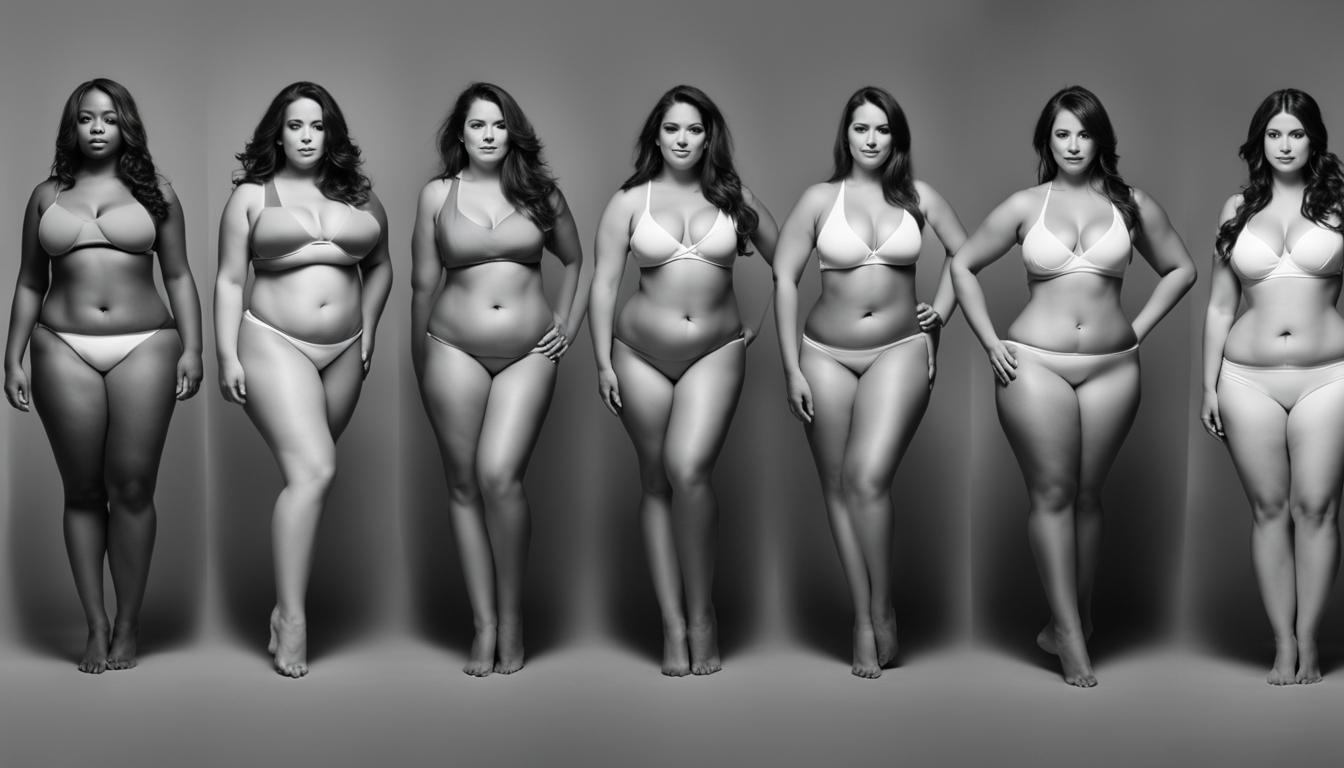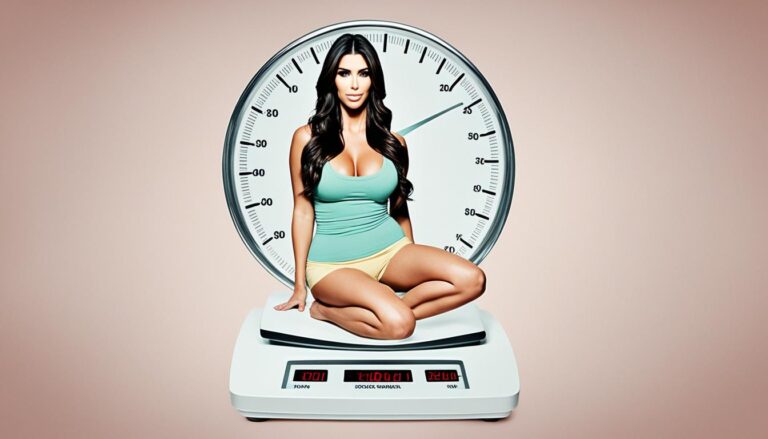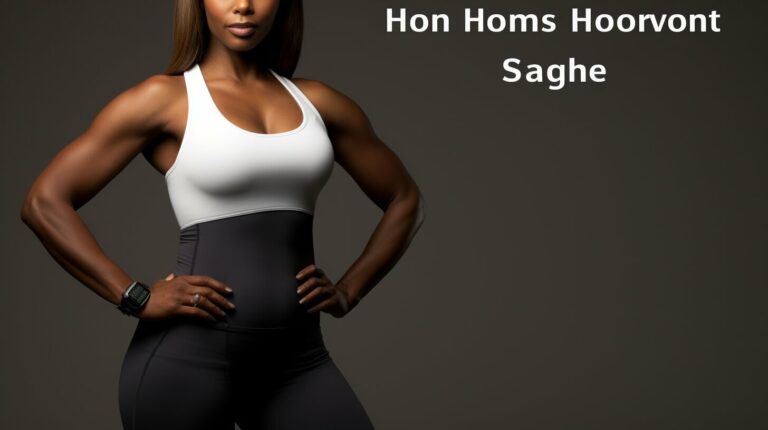What is the thinnest body type?
When it comes to body types, there is a wide range of variations in body shape, size, and composition. Each person has a unique physique that is influenced by several factors, including genetics, lifestyle, and diet. In this article, we will explore the different body types and focus on the thinnest body type.
The thinnest body type is known as an ectomorph. Ectomorphs are characterized by their slender build and small muscles. They have a hard time gaining weight, even with a high-calorie diet. Ectomorphs typically have long limbs and a lean frame. To gain weight naturally, ectomorphs need to consume a diet that is high in carbohydrates and protein. Additionally, engaging in high-intensity interval training can help build muscle and add definition to their physique.
Key Takeaways:
- The thinnest body type is known as an ectomorph, characterized by a slender and lanky build.
- Ectomorphs have difficulty gaining weight, even with a high-calorie diet.
- To gain weight naturally, ectomorphs should focus on consuming a diet high in carbohydrates and protein.
- Engaging in high-intensity interval training can help ectomorphs build strength and muscle mass.
- Understanding your body type can guide you in creating a fitness and nutrition plan that suits your unique needs and goals.
Different Body Types: Ectomorph, Endomorph, and Mesomorph
When it comes to body types, there are three main classifications: ectomorph, endomorph, and mesomorph. Each body type has unique characteristics that determine body composition, skeletal frame, and the distribution of body fat and muscle mass.
Ectomorphs are individuals who have a thin and lanky build. They typically have a small bone structure and struggle to gain weight. Ectomorphs often have fast metabolisms, making it challenging for them to put on muscle mass. They may find it difficult to increase their body weight even when consuming a high-calorie diet.
Endomorphs have a higher percentage of body fat compared to the other body types. They tend to have a rounder shape and store excess weight in the thighs, buttocks, and hips. Endomorphs often have a slower metabolism and may find it easier to gain weight, both in terms of fat and muscle mass.
Mesomorphs are considered the ideal body type due to their balanced muscle-to-fat ratio and natural athletic ability. They have a medium-sized bone structure and tend to build muscle easily. Mesomorphs can achieve a fit and muscular physique with relatively less effort compared to ectomorphs and endomorphs.
While these body types provide a general framework, it’s important to note that individuals may not fit squarely into one category. Many people exhibit characteristics from two or more body types, creating hybrid body types with unique traits.
To give a better understanding, let’s compare the body types using a table:
| Body Type | Characteristics | Skeletal Frame | Body Fat | Muscle Mass |
|---|---|---|---|---|
| Ectomorph | Thin and lanky build, small muscles | Small bone structure | Low | Low |
| Endomorph | Higher body fat, rounder shape | Medium to large bone structure | High | Medium to high |
| Mesomorph | Athletic and muscular build | Medium bone structure | Low to medium | Medium to high |
Understanding your body type can help guide your fitness and nutrition choices. Whether you’re an ectomorph, endomorph, or mesomorph, embracing your unique physique and tailoring your approach to exercise and diet accordingly can lead to improved health and body confidence.
Ectomorph Body Type Characteristics and Recommendations
Ectomorphs are characterized by their slender build and small muscles. They have a naturally thin body type, making it challenging for them to gain weight, regardless of the number of calories they consume.
Ectomorphs often have a fast metabolism, which means they burn calories quickly. This can make it difficult for them to build muscle mass and achieve their desired physique. However, with the right approach, ectomorphs can overcome these challenges and create a strong and well-defined body.
To support muscle growth, ectomorphs should focus on consuming a diet that is high in carbohydrates and protein. Carbohydrates provide the necessary energy for intense workouts, while protein is essential for muscle repair and growth.
High-intensity interval training (HIIT) is highly recommended for ectomorphs who want to build strength and muscle mass. HIIT involves short bursts of intense exercise followed by brief recovery periods. This type of training helps stimulate muscle growth and increases overall fitness levels.
“Training with high intensity helps ectomorphs overcome their natural tendency to have small muscles. By pushing your limits and challenging yourself during workouts, you can stimulate muscle growth and achieve a more defined physique.” – Fitness Expert
It’s important for ectomorphs to avoid excessive cardio exercises that can further accelerate their metabolism and hinder weight gain. Instead, they should focus on strength training exercises that target major muscle groups, such as squats, deadlifts, bench presses, and pull-ups.
Ectomorphs should also ensure they are getting enough rest and recovery. Muscles grow and repair during periods of rest, so it’s essential to allow the body enough time to recover between workouts.

Recommended Approach for Ectomorphs:
- Consume a diet high in carbohydrates and protein to support muscle growth.
- Focus on high-intensity interval training to build strength and muscle mass.
- Avoid excessive cardio exercises and prioritize strength training.
- Ensure adequate rest and recovery for optimal muscle growth and repair.
Endomorph Body Type Characteristics and Recommendations
Endomorphs have a curvy body type with a higher percentage of body fat. Unlike ectomorphs who struggle to gain weight, endomorphs tend to store excess weight in their thighs, buttocks, and hips. The endomorph body type is often characterized by a rounder appearance and a slower metabolism.
To manage their weight and promote overall health, endomorphs should focus on a combination of healthy eating and regular exercise. This includes:
- Reducing carbohydrate intake: Endomorphs may be more sensitive to carbohydrates, so it is recommended to limit the consumption of processed sugars and refined grains.
- Increasing protein and good fats: Including lean sources of protein and healthy fats, such as avocados, nuts, and olive oil, can help promote satiety and support muscle development.
- Engaging in cardio workouts: Regular cardiovascular exercise, such as brisk walking, jogging, cycling, or swimming, can help burn calories and improve overall cardiovascular health.
- Incorporating strength training: By incorporating resistance exercises into their fitness routine, endomorphs can build muscle mass, boost their metabolism, and enhance their body composition.
It’s important for endomorphs to remember that everyone’s body is unique, and individual needs may vary. Consulting with a qualified healthcare professional or a registered dietitian can provide personalized recommendations and guidance based on specific goals and health considerations.
Understanding Endomorph Body Type:
“My body type is endomorph, which means I naturally have a curvier figure and a higher propensity for weight gain. While it may be challenging at times, I know that with the right approach to nutrition and exercise, I can feel good about my body and improve my overall health.”
By adopting a healthy lifestyle that includes a balanced diet and regular physical activity, endomorphs can achieve their fitness goals and embrace their unique body type.
Mesomorph Body Type Characteristics and Recommendations
Mesomorphs are individuals with an athletic and muscular body type. They naturally possess a well-proportioned physique and find it relatively easy to stay fit and build muscle. If you have a mesomorph body type, you are fortunate to have a naturally athletic and strong foundation.
“Mesomorphs have a natural advantage when it comes to achieving a muscular body.”
To optimize your mesomorph body type, it is important to follow a protein-based diet that supports muscle growth and repair. Adequate protein intake is essential for developing and maintaining lean muscle mass. Incorporate lean sources of protein such as chicken breast, fish, tofu, beans, and Greek yogurt into your meals. This will fuel your muscles and aid in recovery.
A balanced exercise routine is crucial for mesomorphs. Engage in a combination of strength training and cardiovascular workouts to maintain your lean physique. Strength training exercises, such as weightlifting and resistance training, will help you build and define your muscles. Cardiovascular workouts, such as running, cycling, or swimming, will improve your endurance and overall cardiovascular health.
Mesomorph Body Type Characteristics:
- naturally athletic and muscular physique
- well-proportioned body shape
- builds and tones muscles easily
- higher metabolism
Mesomorph Body Type Recommendations:
- Follow a protein-based diet to support muscle growth.
- Incorporate strength training exercises into your fitness routine.
- Include cardio workouts to improve endurance and cardiovascular health.
- Stay consistent with your exercise routine to maintain your muscular body.
By understanding and capitalizing on your mesomorph body type, you can achieve your fitness goals effectively. Remember to fuel your body with the right nutrients, engage in regular strength training and cardio workouts, and stay committed to maintaining a healthy and active lifestyle.
| Mesomorph Body Type | Characteristics | Recommendations |
|---|---|---|
| naturally athletic and muscular physique | Follow a protein-based diet to support muscle growth | Incorporate strength training exercises into your fitness routine |
| well-proportioned body shape | Include cardio workouts to improve endurance and cardiovascular health | Stay consistent with your exercise routine to maintain your muscular body |
| builds and tones muscles easily | ||
| higher metabolism |

Determining your body type
To determine your body type, you can take a body shape assessment quiz that considers various physical characteristics. By assessing these factors, you can determine whether you have an ectomorph, mesomorph, endomorph, or a hybrid of two body types.
Some of the important physical characteristics to consider include:
- The width of your shoulders compared to your hips
- The shape of your body, such as hourglass, pear, or pencil
- The size of your bone structure
- Your ability to gain or lose weight
These factors play a crucial role in determining your body shape and structure. Taking a body shape assessment quiz can provide valuable insights into understanding your unique physique and identifying the most suitable approach to diet and exercise.
By knowing your body type, you can customize your fitness goals and adopt strategies that align with your physical characteristics. Whether you aim to gain muscle, lose weight, or maintain a healthy body shape, understanding your body type empowers you to make informed decisions about your overall well-being.
What your body type says about you
Your body type can provide valuable insights into your natural physical characteristics and tendencies. Understanding your body type is essential for tailoring your fitness goals and approaches to diet and exercise accordingly. Let’s take a closer look at the characteristics and traits of different body types:
Ectomorph
Ectomorphs are typically thin and lean individuals who have difficulty gaining weight. They tend to have a slender build with small muscles. If you have an ectomorph body type, you may find it challenging to put on muscle mass or gain weight, even with a high-calorie diet. However, you may excel in endurance activities due to your longer limbs and lean physique.
Mesomorph
Mesomorphs have a more muscular and athletic physique, making them the envy of many fitness enthusiasts. If you have a mesomorph body type, you are naturally inclined to build muscle and maintain a lean body composition. You may have a well-defined bone structure, and your body responds well to both strength training and cardio workouts.
Endomorph
Endomorphs tend to carry more body fat and have a curvy body type. If you have an endomorph body type, you may find it easier to gain weight and build muscle. However, you may also have a higher tendency to store excess fat, particularly in areas such as the thighs, buttocks, and hips. It’s important for endomorphs to focus on a combination of healthy eating and regular exercise to maintain their weight and body composition.
Hybrid Body Types
Some individuals may possess characteristics of multiple body types, known as hybrid body types. For example, an ecto-mesomorph may have a combination of thinness and muscularity, while a meso-endomorph may have both athleticism and a higher body fat percentage. Hybrid body types make each individual unique and require a tailored approach to fitness and nutrition.
By understanding your body type and its inherent characteristics, you can set realistic fitness goals and design an effective exercise and nutrition plan that aligns with your unique needs. Remember, no body type is better or worse than the other; each comes with its own advantages and challenges. Embrace your body type and work towards being the healthiest version of yourself.
Comparison of Body Types
| Body Type | Physical Characteristics | Traits | Fitness Goals |
|---|---|---|---|
| Ectomorph | Slender build, small muscles | Difficulty gaining weight, lean physique | Build muscle mass, increase weight |
| Mesomorph | Muscular, athletic physique | Naturally build muscle, maintain lean body composition | Strength training, maintain physique |
| Endomorph | Curvy body type, higher body fat percentage | Easier weight gain, higher fat storage | Manage weight, build muscle |
| Hybrid Body Types | Combination of multiple body types | Unique blend of physical traits | Tailor fitness goals to individual characteristics |
Conclusion
Understanding body types and their impact on physical characteristics and body composition is essential for establishing realistic goals and designing effective fitness and nutrition plans. Whether you identify as an ectomorph, endomorph, mesomorph, or have a hybrid body type, embracing your unique physique and adopting healthy habits can contribute to overall well-being and body confidence.
People with the thinnest body type, known as ectomorphs, may struggle to gain weight despite a high-calorie diet. To improve their body composition, ectomorphs can focus on consuming a diet rich in carbohydrates and protein and engaging in high-intensity interval training to promote muscle growth.
For individuals with a curvy body type, such as endomorphs, managing weight may involve a combination of healthy eating and regular exercise. This includes reducing carbohydrate intake, increasing protein and good fats, and incorporating cardio and strength training exercises into their routine.
Mesomorphs, considered the ideal body type, naturally have an athletic and muscular physique. To maintain their lean physique, mesomorphs can follow a protein-based diet and engage in a combination of strength training and cardio workouts.
FAQ
What is the thinnest body type?
The thinnest body type is known as an ectomorph, characterized by a slender and lanky build. Ectomorphs have a hard time gaining weight, even with a high-calorie diet. They have a lean build, long limbs, and small muscles. To gain weight naturally, ectomorphs must consume a diet high in carbohydrates and protein and engage in high-intensity interval training.
What are the different body types?
There are three main body types or somatotypes: ectomorph, endomorph, and mesomorph. These body types differ in terms of their skeletal frame and body composition. Ectomorphs have a thin and lanky build with small muscles and struggle to gain weight. Endomorphs tend to have a higher percentage of body fat and store excess weight in their thighs, buttocks, and hips. Mesomorphs are considered the ideal body type, with a balanced muscle-to-fat ratio and a natural tendency to stay fit.
What are the characteristics and recommendations for an ectomorph body type?
Ectomorphs have a slender build and small muscles. They have difficulty gaining weight, regardless of their caloric intake. Ectomorphs should focus on consuming a diet high in carbohydrates and protein to support muscle growth. High-intensity interval training is recommended to build strength and muscle mass.
What are the characteristics and recommendations for an endomorph body type?
Endomorphs have a curvy body type with a higher percentage of body fat. They tend to store excess weight in their thighs, buttocks, and hips. To manage their weight, endomorphs should focus on a combination of healthy eating and regular exercise. This includes reducing carbohydrate intake, increasing protein and good fats, and engaging in cardio and strength training exercises.
What are the characteristics and recommendations for a mesomorph body type?
Mesomorphs have an athletic and muscular body type. They have a natural tendency to stay fit and build muscle easily. Mesomorphs should follow a protein-based diet that supports muscle growth and repair. They should engage in a combination of strength training and cardio workouts to maintain their lean physique.
How can I determine my body type?
You can determine your body type by taking a body shape assessment quiz that considers various physical characteristics. These include the width of your shoulders compared to your hips, the shape of your body (hourglass, pear, pencil), the size of your bone structure, and your ability to gain or lose weight. By assessing these factors, you can determine whether you are an ectomorph, mesomorph, endomorph, or a hybrid of two body types.
What does my body type say about me?
Your body type can provide insights into your natural physical characteristics and tendencies. Ectomorphs are typically thin and lean with difficulty gaining weight. Mesomorphs have a more muscular and athletic physique. Endomorphs tend to carry more body fat but can build muscle easily. Hybrid body types, such as ecto-mesomorphs and meso-endomorphs, combine traits from multiple body types. Understanding your body type can help you tailor your fitness goals and approaches to diet and exercise accordingly.
How do body types affect overall health?
Body types play a significant role in shaping an individual’s physical characteristics and body composition. Understanding your body type can help you establish realistic goals and design effective fitness and nutrition plans. Whether you have an ectomorph, endomorph, mesomorph, or hybrid body type, embracing your unique physique and adopting healthy habits can contribute to overall well-being and body confidence.
Is there a conclusion to this topic?
The thinnest body type is known as an ectomorph, characterized by a slender and lanky build. Ectomorphs have difficulty gaining weight, regardless of their caloric intake. They should focus on consuming a diet high in carbohydrates and protein and engage in high-intensity interval training. Understanding your body type and embracing your unique physique can help you set realistic goals and maintain a healthy lifestyle.






